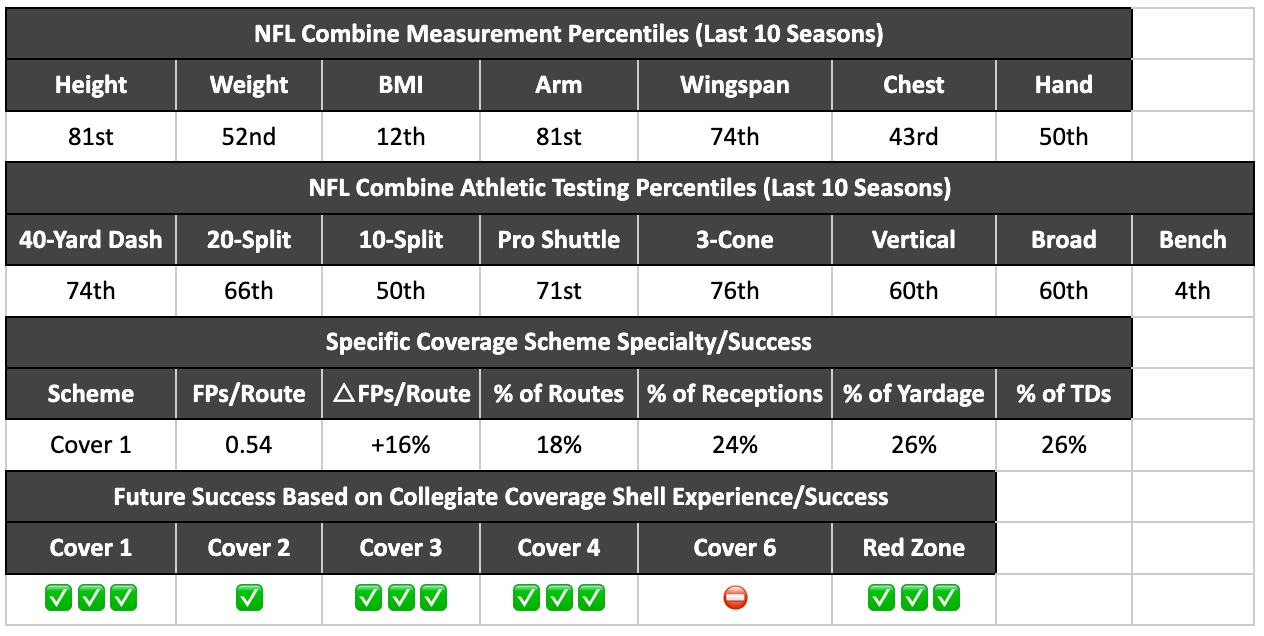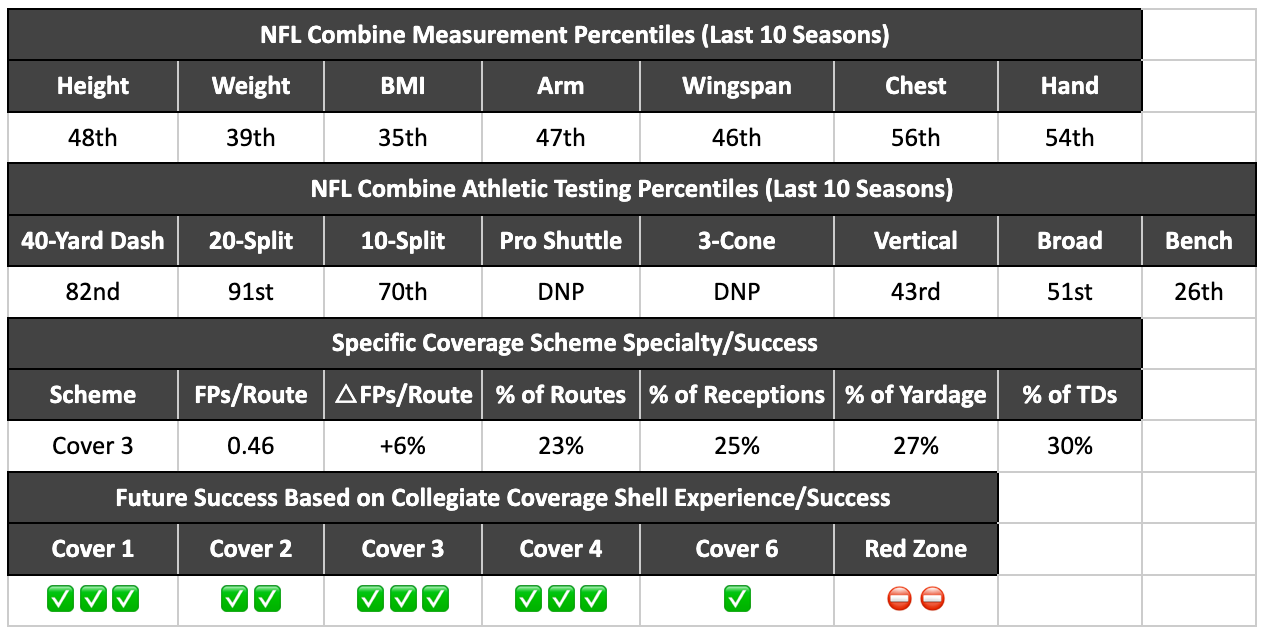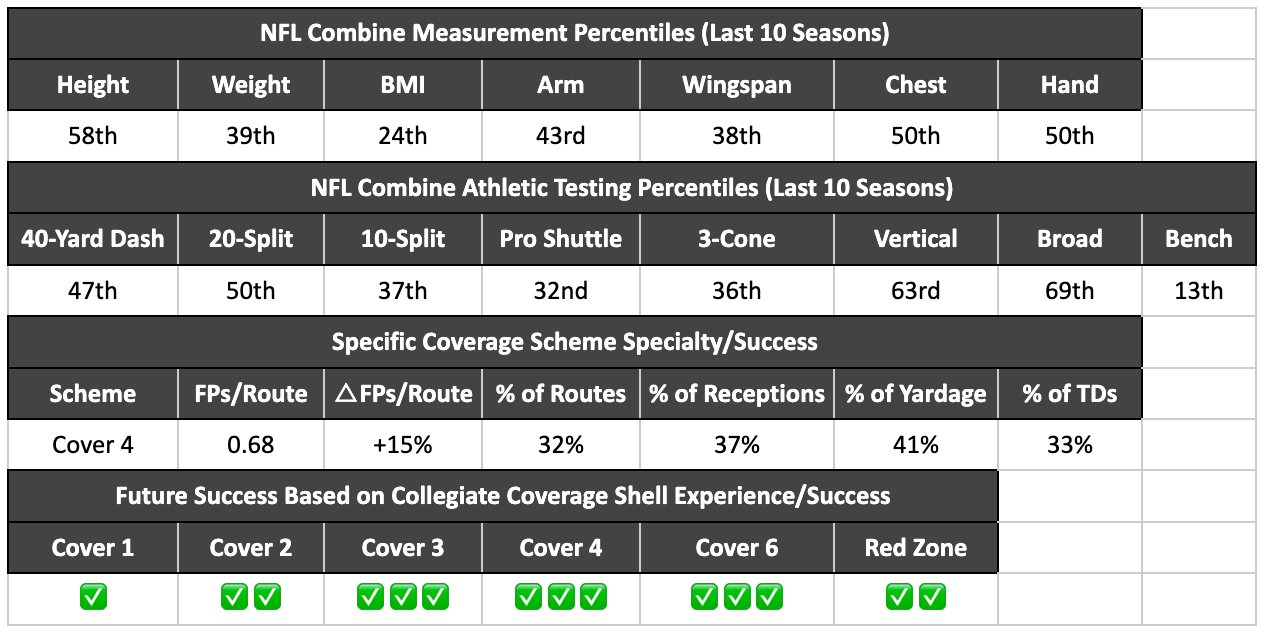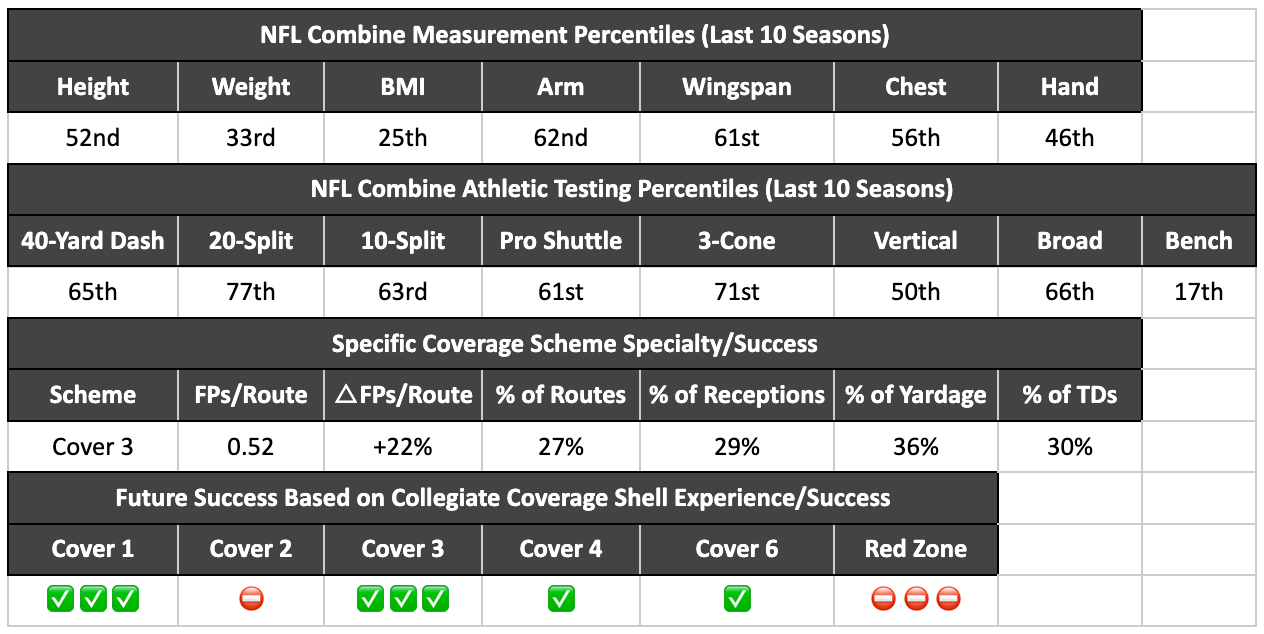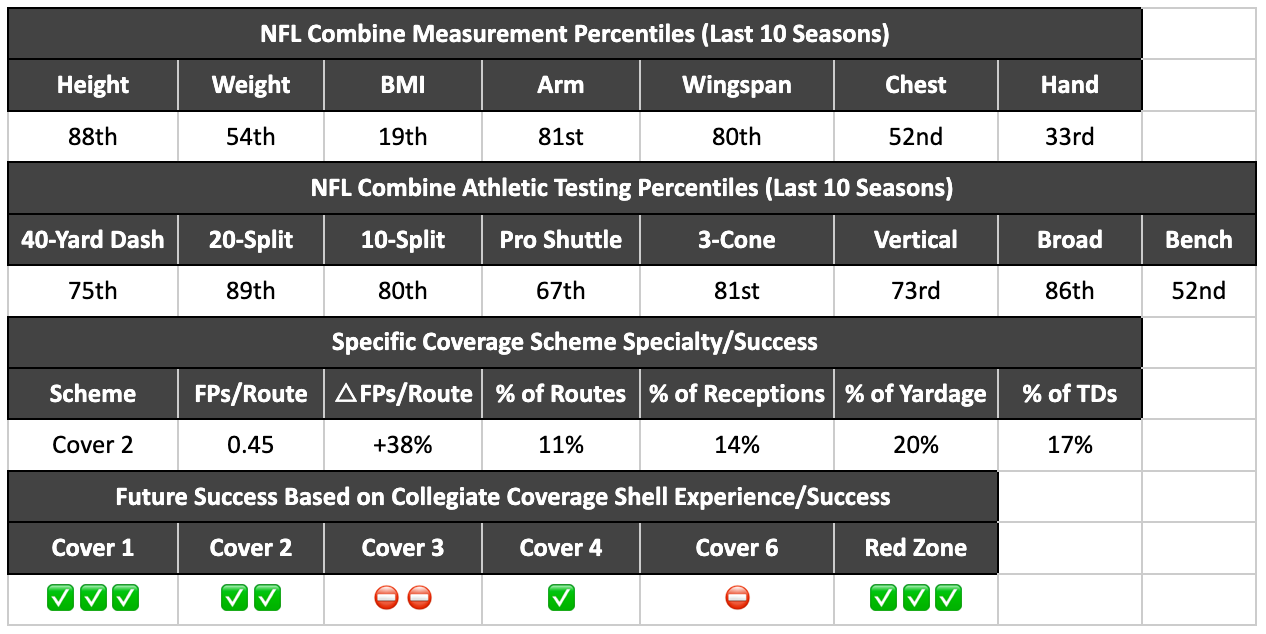| Class Rank | Player | College | DOB | Age (Week 1) |
| TE1 | Charlie Kolar | Iowa State | 2/10/99 | 23.7 |
| TE2 | Trey McBride | Colorado State | 11/22/99 | 22.9 |
| TE3 | Isaiah Likely | Coastal Carolina | 4/18/00 | 22.4 |
| TE4 | Greg Dulcich | UCLA | 3/26/00 | 22.5 |
| TE5 | Jelani Woods | Virginia | 10/9/98 | 23.11 |
| TE6 | Jeremy Ruckert | Ohio State | 8/11/00 | 22.0 |
| TE7 | Jake Ferguson | Wisconsin | 1/18/99 | 23.7 |
| TE8 | Peyton Hendershot | Indiana | 4/23/99 | 23.4 |
| TE9 | Gerrit Prince | UAB | ?/?/97 | 25+ |
| TE10 | Chigoziem Okonkwo | Maryland | 9/8/99 | 23.0 |
Charlie Kolar | 6-foot-6 ⅝” | 252 lbs. | Iowa State Cyclones
Your eyes are not fooling you, Charlie Kolar is ranked ahead of Trey McBride. Should that be an indication that the separation between the two is massive? No sir. It’s very close, the pair make up the cream of the crop in this class. True to form from the TE position, several of the top entries anticipated to enter the ‘22 class failed to live up to expectations and transferred to another school (Austin Stogner, Jahleel Billingsley, etc.), while others emerged late to push their way to the top of the draft class (McBride, Jelani Woods, etc,).
Prior to joining Iowa State from the class of 2017 out of Norman North High School, Kolar was not evaluated to excel by the scouting circuit. It’s uncommon to find tight ends that typically experience significant growth bursts during their HS days while still producing big numbers. For most, simply finding their way toward gaining coordination is challenging enough. But Kolar collected 118 receptions, 2,161 yards, and 25 TDs over his last two seasons combined for the Timberwolves.
Charlie Kolar's 63 catches in 2021 were the most by a P5 TE in a season since 2017 🌪pic.twitter.com/ORcQP15gur
— PFF Draft (@PFF_College) March 20, 2022
Most Power Five (P5) programs ignored Kolar, with his only P5 offer coming from Iowa State. Even former Cyclones' TE coach/recruiting coordinator Alex Golesh was blown away by Kolar’s abilities once he had an opportunity to put eyes on him in Ames. It wasn’t until Chase Allen, another ‘22 prospect, suffered a groin injury in Week 3 of 2018 that a path opened up for Kolar to establish himself as one of the program benchmarks. With prep scouts questioning whether Charlie would ever have the functional strength to have an impact as a blocker, Kolar proved concerns to be misplaced after playing a massive role in the careers of David Montgomery and Breece Hall.
By Year 2 in OC Tom Manning's system, the stage was set for Kolar to erupt. Kolar improved his yards gained/route run (YPRR) on targets traveling at least 20 air yards by 71% and by 55% on intermediate targets (10-19 air yards) during that breakout season. And Kolar seemed to hit the field with an almost innate understanding of properly attacking most coverage schemes. Charlie’s play from his final three seasons in Ames gave him the opportunity to bring home a litany of awards. We’ll take the bulleted list route:
Second Team All-Big 12 (Coaches – 2018)
First Team All-Big 12 (Coaches – 2019, 2020, 2021)
Mackey Award Semifinalist (2019)
Second Team All-American (FWAA – 2019, Walter Camp & AFCA – 2020)
Third Team All-American (AP – 2019, 2020)
Mackey Award Finalist (2020, 2021)
William V. Campbell Trophy Winner (2021)
One guy NFL scouts are higher on than media is Iowa State’s Charlie Kolar. TE coaches from Falcons, Eagles, Giants, Saints, Cards, and Titans were at @CycloneFB pro-day today. Looked noticeably different this year from junior tape in terms of bend & fluidity. Nice look here: pic.twitter.com/5dkKX7S2Xb
— Jim Nagy (@JimNagy_SB) March 22, 2022
Kolar answered early scouting concerns as to his muscle mass through packing on 25 pounds to his frame. Questions about his potential blocking base were eliminated after a big showing during the ‘21 season when his hand placement and fluidity shined. As for the early predictions he'd only fit within a spread scheme, Kolar posted a 28% higher YPRR with 12-personnel, 33% more with 13-personnel than when working in 11-personnel (spread) sets. Kolar has shown he can be effective when attached inline, from the slot or even out wide. In addition, he is the jewel in the crown from the TE class against Cover 1 and inside the red zone (RZ). Kolar’s route profile is spotless and, sans his poor 225-pound bench press showing, he blew up at his ISU Pro Day.
Trey McBride | 6-foot-3 ⅝” | 245 lbs. | Colorado State Rams
It’s difficult to find many faults in Trey McBride’s game. He exploded onto the scene at Fort Morgan High School with 62 receptions, 1,201 yards, 12 TDs, 318 rushing yards, three TDs, 164 tackles, 37 TFLs, 8.5 sacks, two INTs and three blocked punts – phew – during his final two seasons with the Mustangs. Both efforts unsurprisingly earned him CHSAA 3A First Team All-Colorado honors.
McBride also hit .452 with a 1.395 OPS, while blasting the most home runs (23) and accounting for the most RBIs (117) in school history during his baseball career. And that’s not even all! He averaged 17.5 PPG, 10.0 RPG, 1.5 SPG and 1.7 BPG on the basketball court over his last three seasons. The 1,334 points he scored during his career are also a Fort Morgan record.
That cross-sport experience from the diamond and hardcourt is significant since it’s an all too common factor for many of the longer receivers finding success at the NFL level. There’s no denying the impact of those sports – particularly basketball – in assisting young athletes with coordinating their bodies to the extreme growth spurts experienced by TEs. Following a true freshman season as a backup at Colorado State, McBride continued stocking his trophy case with a collection most would do anything to acquire:
First Team All-Mountain West (2019)
Second Team All-Mountain West (2020)
John Mackey Award (2021)
Unanimous First Team All-American (2021)
First Team All-Mountain West (2021)
First Team Senior Bowl Offensive Player of the Week (Week 3)
Trey ended his final season in Fort Collins by pacing all FBS TEs in receptions (90), yards (1,121) and YPG (93.4). His ‘21 receiving yardage total is the fifth-most by a TE in FBS history and (obviously) set the standard in the MWC. And that big season is the source for McBride’s skyrocketing ascent toward the top of the ‘22 TE class. However, prior to posting those incredible reception and yardage numbers, this ultra-talented young man established a considerable reputation as a mauling run blocker.
When you've given as much as @Mcbtrey has, all we can say is...
— Colorado State Football (@CSUFootball) December 10, 2021
𝗧𝗵𝗮𝗻𝗸 𝗬𝗼𝘂. 💚
Presenting your 2021 @JohnMackeyAward Winner ‼️ pic.twitter.com/lLS140Qb2r
For his career, McBride has averaged at least 0.40 FPs/route against Cover 1, 2, 3, 4 and 6. That said, the finality of those impressive averages followed an inconsistent path. For example, Trey struggled quite a bit with efficiency against Cover 2 and 6 last season. But he crushed Cover 1 and 4, and McBride fired AGM-114 Hellfire surface-to-surface, high-explosive anti-tank guided missiles at every Cover 3 he laid eyes upon.
The thing about his impressive averages is that we know his scheme numbers fell short at one point, but we know that Trey also excelled against each at various stages along the way. McBride very nearly concluded his CSU career averaging at least 2.00 YPRR against all five of those common schemes. The one area of the field where McBride struggled is inside the RZ. During 40 career games with the Rams, McBride caught all of three passes inside the 20.
If you take a step back to mull it over, only scoring one TD for every four games played is a considerable concern. It was one of the major factors preventing Trey from pushing himself ahead of Kolar. Even with the lack of house visits, McBride is going to be a stud addition at the most desolate position in fantasy. Be warned, the drop-off after Kolar and McBride in this class is considerable.
Isaiah Likely | 6-foot-4 ½” | 245 lbs. | Coastal Carolina Chanticleers
The distinction for landing third on this list is a tight one between Isaiah Likely and Greg Dulcich. We don’t have the reported statistics from Likely’s senior season at Everett High School. What we do know is that he generated 59 receptions, 917 yards and 11 TDs during his junior season – a near mirror image to the counting stats he created last season for Coastal Carolina. We also know he was honored MIAA First Team All-State for his senior production. In addition, Likely helped his Crimson Tide squad to a 24-3 record and back-to-back MIAA Division I Super Bowl state championships.
It seems the avenues of communication for scouts covering the top prospects hailing from Massachusetts’ high schools is somehow restricted. The recruiting process for Pat Freiermuth drew far less attention than deserved, and Likely followed that same fate in spite of his outstanding results for the top high school in the state. Likely’s only P5 offer came from Boston College. He ended up accepting an offer to play in Conway, South Carolina for the Chanticleers. And he certainly didn’t fail on his end of that scholarship deal after collecting the following accolades:
All-Sun Belt Third Team (2019)
All-Sun Belt First Team (2020)
John Mackey Award Semifinalist (2021)
Second-Team All-American (FWAA & Walter Camp – 2021)
All-Sun Belt First Team (2021)
Teaming up with Grayson McCall – on a strong path to being one of the top-five QBs in the 2023 class – elevated Coastal Carolina from an afterthought in the Sun Belt to one of the top programs in the entire Group of Five (G5). The major weakness in Likely’s game were some struggles against Cover 1. However, Likely made some strides in attacking that variation of man coverage last season. If Isaiah can continue to show he’s overcome his one-on-one challenges, his game would grow closer to becoming scheme independent.
The only detail that prevented Likely from building a zone coverage dynamo résumé at Coastal Carolina was a lack of Cover 2 snaps. Likely had his way with defenses in Cover 3, 6 and inside the RZ. Similar to Kolar against Cover 1 and inside the RZ and when McBride faced Cover 3, Likely simply annihilated Cover 4. You can find his career numbers against the scheme in the table above, but the Cover 4 statistics he created last season must be addressed. Likely manufactured 4.39 YPRR, 13.7 YPT and a 144.4 targeted passer rating (TPR) when working against Cover 4/Quarters. It resulted in a mind-blowing 1.00 FP/Rt! He very nearly extracted half of his receiving numbers against that single scheme.
It should be common knowledge across the dyno community that the more athleticism at RB, WR and TE, the better they’ll serve our rosters. It’s all about that youth and athleticism. But the position that requires the least amount of brain power in determining which testing components are the most important is at TE. Just shovel that nonpareil virility into a bucket. To that end, Likely fell short in showing off blistering speed or swift change-of-direction. Be that as it may, Likely was able to place a spotlight on his explosion with a 36” vertical and 123” broad jump.
With a powerful bio of coverage shell success, a history of featured achievement at every stop and an athletic profile detailing competitive speed and impressive explosion, Likely should be a desirable commodity in the final rounds of rookie drafts. Likely will bring a rock-solid run blocking reputation with relentless effort. And that immediate path to playing time should bring about decent returns during his rookie season.
Greg Dulcich | 6-foot-4 | 242 lbs. | UCLA Bruins
If the purpose of the search is to discover top athletes and a near-spotless coverage scheme profile of success, draft McBride or Kolar. That’s precisely what sets them apart from the rest of the class. With Likely, you get the solid coverage success, without the sexy athleticism. In the case of Greg Dulcich, we have the opportunity to roster a faster TE, tremendous change-of-direction footwork and plenty of explosion. However, he has found his success against highly specific opponents. If you know me, you know I heart weapons that can properly get after Cover 1. And Dulcich is also adept at attacking the one shell that we see, on average, at an even higher rate than Cover 1, Cover 3. It’s unfortunate that it must be passed along that the coverage success ends there.
Dulcich is no stranger to adversity. He prepped at St. Francis High School in La Cañada Flintridge, California. His first two years were spent attempting to lock down the starting QB job on the junior varsity team. Dulcich was forced to move to TE after Darius Perrantes transferred in from nearby Crespi High. Undeterred, during his junior and senior seasons, Dulcich caught 80 balls, for 1,574 yards and 16 TDs. He added another 354 yards on the ground and five TDs. While he led the Golden Knights to the CIF Southern Section Division III championship game, even with Dulcich accounting for a 4/126/1 receiving line, his squad suffered a devastating 44-42 defeat to the Rancho Verde Mustangs. It ended a two-season stretch where Dulcich’s teams posted a 21-4 combined record. Even attending high school a mere three miles from the Rose Bowl, Dulcich failed to draw any interest from his beloved Bruins.
@SFGoldenKnights Greg Dulcich (16) makes a catch to score during the first half of a CIF Southern Section Division III semifinal prep football game against El Torro at St Francis High School in La Canada, Calif., Nov. 24, 2017. (Photo by Libby Cline Birmingham) pic.twitter.com/LktF0WVgDy
— Elizabeth (@LCphoto13) November 25, 2017
In those days, UCLA had the luxury of having Caleb Wilson in the midst of submitting the finest season for a TE in program history. They had also added transfer Devin Asiasi from the University of Michigan – the TE3 from the class of 2016 – who took over as the starter during the 2019 season. It wasn’t until Derek Sage, Washington State’s outside WR coach, had the opportunity to check out the gangly 6-foot-3, 210-pounders tape that Dulcich finally managed to get his foot into the door of the P5 program he was determined to attend. A former TE for Sacramento City College and Cal State Northridge, Sage just so happened to be on his way to join Chip Kelly’s staff as the new TE coach at UCLA – Kelly previously gave Sage his first coaching job at the University of New Hampshire in 2005.
Sage successfully convinced Kelly to give Dulcich a shot and, in order to play for the Bruins, Greg was required to join as a preferred walk-on. Two seasons of mainly special teams work and 32 pounds of additional muscle later, Dulcich was awarded a full scholarship prior to the COVID-shortened 2020 season. It was a decision Kelly would not regret after Dulcich combined for 68 receptions, 1,242 yards and 10 TDs over the next two seasons. Greg enters the ‘22 draft after generating the 10th-most FP/Rt (0.42), fifth-most YPRR (2.12), second-most YPT (11.8) and second-most air yards/target (13.6).
💥🏈💥 @Greg_Dulcich ‼️pic.twitter.com/gT256oOfbH
— UCLA Football (@UCLAFootball) September 5, 2021
As mentioned, the ‘21 John Mackey Award semifinalist and All-Pac-12 First Teamer has a ton of upside across from the one-on-one matchups found inside a Cover 1. But his work against Cover 3 accounted for around a third of his production. Among the TEs in the ‘22 class, Dulcich’s work against Cover 3 resulted in the most YPRR, YPT, air yards/target and third-most FP/Rt. Either through a lack of opportunities (Cover 6) or inefficiency (Cover 2 and 4), Dulcich will face additional adversity in his future before landing a consistent role at the next level. The most concerning aspect of Dulcich’s game is the barren wasteland where we should find his RZ production. Dulcich didn’t catch a single pass inside the 20 during his entire four-year career at UCLA.
The athletic testing tells the story of a kid who worked his butt off to transform his body from a lanky frame into one capable of assaulting Pac-12 defenses. An all out focus on taking his game to the next level is all we can ask in exchange for our late-round rookie draft capital. Keep in mind, Dulcich doesn’t come remotely close to matching the run blocking excellence of Kolar, McBride or Likely. That’s a factor that will greatly restrict Dulcich’s opportunities to land a significant role during his rookie season. We know this young man is game to accept the NFL challenge head-on, but we will need to restrict rostering Dulcich to the dyno formats with deeper rosters.
Jelani Woods | 6-foot-7 ⅛” | 252 lbs. | Virginia Cavaliers
We have the elite (McBride and Kolar) and we have the upside projects (Likely and Dulcich). Jeremy Ruckert or Jake Ferguson could easily be considered in this spot with their solid floor projections, but Jelani Woods takes the real estate due to an immense ceiling. Let’s just word his coverage scheme profile as a work in progress. A big ‘21 showcase of Cover 1 improvement really stands as the sole statistical reasoning for Woods’ impressive ascent. On his ‘21 tape, we saw that Woods was able to highlight his flexibility working inline, inside and on the perimeter. However, everything came together to add sparkle to Woods’ NFL shine after he had a chance to show off his athleticism.
Woods has been a father figure to his older, moderately intellectually disabled brother, Javaric, since he was 14. He is an accomplished drummer and averaged 16 PPG, 4.5 RPG and 4.5 APG on the basketball court during his senior year for Cedar Grove High School. But Woods actually devoted his HS career to playing QB for the Saints’ football team. And it was a legit offense, as well, fielding a flexible spread scheme. While leading Cedar Grove to a 13-2 record as a senior in 2016, Woods, paired with Jadon Haselwood, took down Davis Mills’ Greater Atlantic Christian Spartans in the championship game of the GHSA 3A Playoffs.
2nd team all region QB 2017 Jelani Woods 6'5"220 of Cedar Grove looking at AUB,ARK,TENN,AL,FSU,NC ST,CLEM and OSU. pic.twitter.com/2EsfzGQTnn
— Tom Lemming (@LemmingReport) January 30, 2015
Woods took home GHSA 3A First Team All-Region honors after his final prep season in recognition for his 1,992 passing yards, 20 TDs vs. six INTs and adding another 15 TDs with his legs. He was actually recruited to Oklahoma State University to play QB. That didn’t last long, making a permanent switch to TE at the end of his 2017 redshirt season without ever taking a snap from under center. Woods hit the transfer portal after finishing off his bachelor’s degree in Stillwater, finding a chance to flaunt his receiving skills at the University of Virginia.
The tape from Woods’ ‘20 season provided us with some promising improvements as a run blocker. Much of that progress was lost in the transition to UVAs Air Raid offense. His obvious lack of core strength in his 19th-percentile BMI screams the need to pack on additional mass. Not to mention that his hand placement is a complete mess. Woods won with the Cavs last season across from man coverage. It’s where he collected well over a third of his offense. He also established himself as a considerable RZ threat (six targets, four TDs). Woods made outstanding progress in finding success on drags, outs and hitches last season that will set him up well for his NFL transition.
Virginia TE Jelani Woods is 6’7”, 259 lbs and ran a 4.61 40-yard dash Thursday at the NFL Combine. 💨
It’s the fastest 40-yard dash time by a TE taller than 6'7" since 2003.
🎥
The alignment flexibility and considerable boost in production during his final season were great. That said, it’s what he accomplished between the Combine and Virginia Pro Day that brought eyes onto his front porch. Standing over 6-foot-7 and with a near 83-inch wingspan, Woods ran a 4.61-second 40-time, 20-split of 2.62 and 10-split of 1.57. But wait, there’s more. His 6.95-second 3-Cone time was only surpassed by Peyton Hendershot among all TEs at the Combine or from any Pro Day across the country. Woods also flashed his outstanding explosion with a 37 ½” vertical and 129” broad jump.
As for the downside, Woods requires considerable coaching on defeating Cover 3, in particular, and Cover 6. Unless we see Woods moved to WR, failing to excel against Cover 6 is not much of an issue. Most TEs stand on the sidelines against the majority of the Cover 6 looks an offense faces. But it’s imperative that Woods eliminates the drifting approach he put on tape across from Cover 3 last season. Particularly since we will likely need to wait for Jelani to add some bulk to his core before he’s trusted with any run blocking responsibilities. Woods is a bit of a project, so we will only consider selecting him in rookie drafts in very deep formats. Just make sure you keep the name in mind if/when he starts showing up in games where he receives enough offensive snaps to make a difference.


